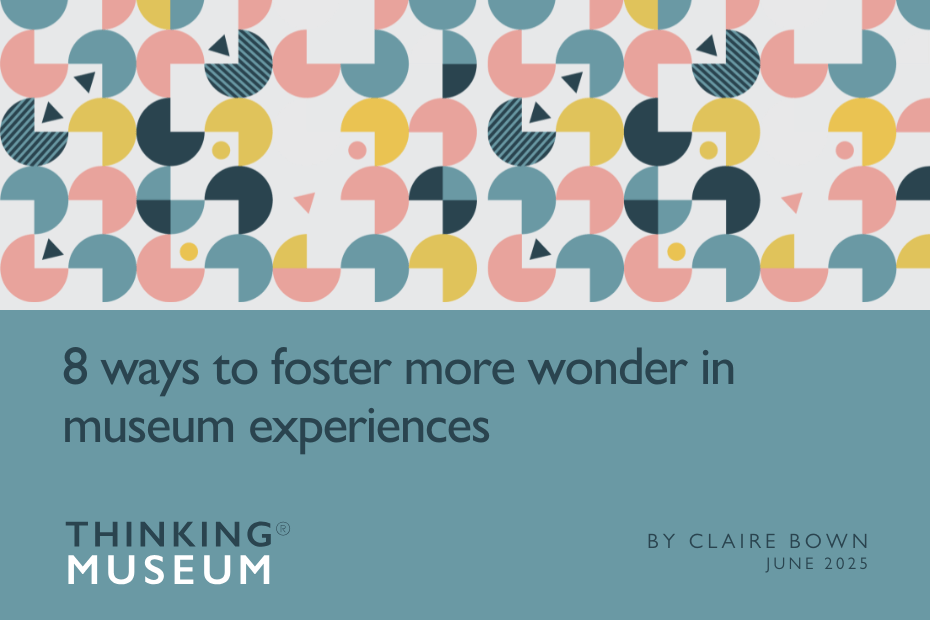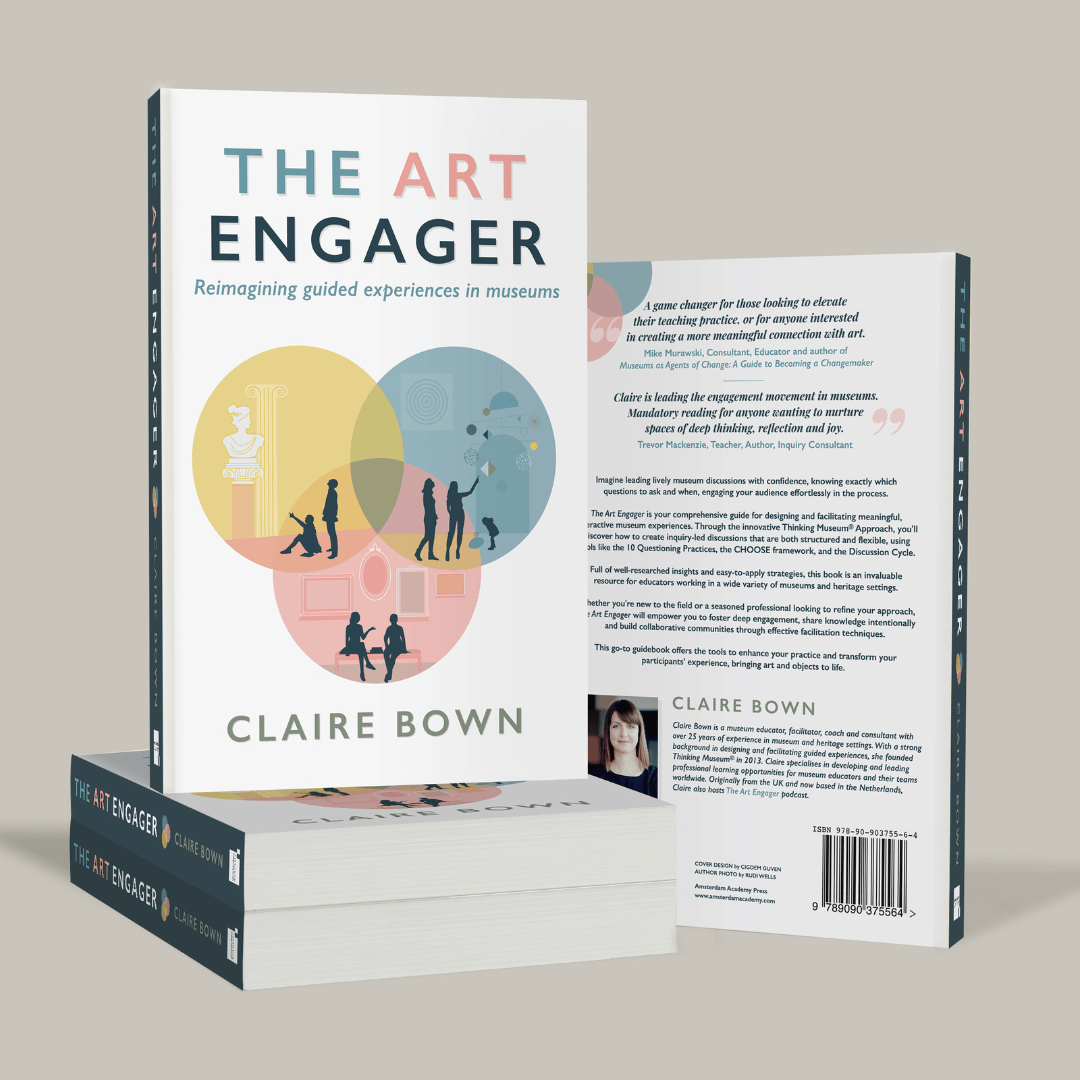Wonder is one of those words we use all the time in museums. We talk about creating wonder, fostering wonder, inspiring wonder. But what exactly do we mean when we say we want to foster it? And more importantly, how do we actually do it in our guided experiences?
These are the questions I want to explore today. We’ll start by looking at what wonder really is – and how it’s different from awe and curiosity. Then we’ll explore why museums are such special places for wonder, and why we often lose that natural capacity for wonder as we get older. Finally, I’ll share eight practical strategies you can use to invite more wonder into your guided experiences.
Support The Art Engager podcast on Patreon.
What is wonder?
So, let’s start with wonder itself. It’s a familiar term and probably one we use often. But what exactly are we talking about when we say we want to foster “wonder”?
Well, there are actually two different meanings of the word “wonder.” Wonder as a verb means to think about something or ask questions – like “I wonder how they made this” or “I wonder what this was used for.”
But we’re talking today about wonder as a noun and this is specifically a feeling – it is defined as:
“a feeling of amazement and admiration, caused by something beautiful, remarkable, or unfamiliar.”
It’s wonder in the sense of “he looked at the artwork with the wonder of a child” – a feeling of being amazed and completely captivated by something.
Wonder, awe, and curiosity: what’s the difference?
So what’s the difference between wonder, awe, and curiosity?
Wonder is about delight and captivation – you’re drawn to something beautiful or remarkable.
Awe tends to be more overwhelming – it’s what you feel in the presence of something vast or powerful that makes you feel small, like standing at the edge of the Grand Canyon.
Curiosity, on the other hand, is the active drive to know more – it’s what motivates you to ask questions and seek answers.
While these often occur together – wonder can spark curiosity, awe can leave you speechless, or curiosity can lead to moments of wonder or awe – they’re distinct experiences that each bring something different to our encounters with art and objects.
The many faces of wonder
Recent thinking suggests that wonder isn’t just ‘one thing’ either – it might show up in many different ways:
- There’s intellectual wonder – that spark when learning about an artwork’s technique completely changes how you see it.
- Sensory wonder comes from really noticing the texture of brushstrokes, the way light hits a sculpture, or details you’d normally walk past.
- Natural wonder might hit you when standing before a massive dinosaur skeleton or examining intricate fossils.
- Spiritual wonder connects us to something bigger – perhaps through sacred objects or artworks that touch the transcendent.
- Relational wonder arises when you imagine the hands that crafted a ceramic bowl or feel connected to other visitors sharing the experience.
- Historical wonder strikes when you realise you’re looking at something someone held 2,000 years ago.
- Creative wonder celebrates human imagination – marvelling at what people can create with their hands and minds.
- And reflective wonder invites big questions about humanity, beauty, and our place in the world.
These aren’t fixed categories per se, but they help us notice how many ways wonder can appear – and how museums offer rich spaces to experience them all.
Museums are special places for wonder. They offer us access to the remarkable. They present us with things from different times, places, and cultures that expand our understanding of what’s possible in the world.
And perhaps most importantly, museums give us permission to slow down and really look – to spend time with something purely for the sake of paying attention to it.
Why we lose wonder
But as we get older, most of us lose some of that natural capacity to wonder that we had as children.
This happens for lots of different reasons.
Sometimes it’s simply familiarity – when you see the same things over and over again, they stop surprising you.
Sometimes it’s about pace – our busy lives don’t leave much room for the kind of slow attention that wonder requires.
Sometimes it’s about expectations – we think we already know what we’re going to see, so we stop really looking.
Sometimes it’s about routine – we develop patterns and habits that become comfortable but also predictable. And sometimes it’s just life – when you’re tired, stressed, or overwhelmed, it’s hard to access that sense of openness and curiosity that wonder needs.
So how can we reawaken this sense of wonder in our guided experiences?
Let’s look at some strategies that invite it in.
Here are 8 ways to invite more wonder during a guided experience:
1. Pause and invite slow looking
Encourage participants to spend an intentional moment just observing without rushing. Say something like, “Let’s all take 30 seconds just to quietly look and notice what stands out to you.” Slow looking helps people move beyond surface impressions and notice details that can spark awe and curiosity – key components of wonder.
2. Encourage beginner’s mind
Invite participants to look at the artwork or object as if they’ve never seen anything like it before – setting aside prior knowledge or assumptions. You might say, “Try to forget what you (might) know about this and try to approach this with complete openness.”
If it’s a very famous artwork, invite participants to notice something they’ve never noticed before – a small detail, the way light hits a surface, a facial expression you hadn’t caught before. Looking at something with fresh eyes rewires our attention patterns and helps to overcome habituation – our brain’s tendency to filter out familiar things. This simple shift opens up new ways of seeing and invites wonder through discovery.
3. Use sensory anchors beyond sight
You want to be using a range of modalities in your guided experiences. And this includes all the senses. Prompt participants to think about what they might hear, feel, or even smell if they were in the scene or touching the object. Engaging multiple senses deepens connection and enriches the experience of wonder.
4. “What if I was to tell you…?”
One simple but powerful strategy to foster wonder is to share a surprising or unexpected chunk of information or micro-story about the artwork or object, starting with the phrase, “What if I was to tell you…” For example, “What if I was to tell you this seemingly simple object was once a symbol of political rebellion?” or “What if I was to tell you the artist created this under quite unusual circumstances?”
Why does this work? Because it gently challenges what participants think they already know. That moment of surprise breaks the usual way of thinking and sparks curiosity. It invites people to reconsider their assumptions and opens up a fresh perspective. When participants start seeing the object in a new light, that mix of curiosity, amazement, and awe – what we might call wonder – naturally begins to emerge.
5. Pose an open-ended ‘what if’ scenario
In the same vein, you can encourage creative thinking with an open-ended “What if” question. For example, “What if this object was made from a different material – how would that change how it feels or looks to you?” or “What if this painting was created 100 years earlier – how might it look different?”
You can also focus on specific details, like colour or composition: “What if the artist had removed this bright red from the painting – how would that change how it feels?” or “What if this sculpture were painted in a completely different colour – how might that affect what you notice or feel?”
These prompts encourage participants to imagine alternatives and explore the object in new, unexpected ways – opening the door to wonder.
6. Invite multiple perspectives
Wonder grows when people hear different ideas and ways of seeing the same object. As a facilitator, you can encourage participants to share what they notice, feel, or think, and highlight that there’s no single “right” answer. For example, you might say, “What’s one detail you noticed that others might not have seen?” or “How does this artwork make you feel?”
By valuing everyone’s unique response, you create a space where participants feel safe to explore and express their ideas. Hearing different viewpoints invites them to reconsider their own, which can surprise and delight – helping wonder to deepen as they realise there’s more to discover than they first thought.
7. Connect the object to participants’ own stories
Another way to foster wonder is to connect the object to participants’ own stories. You might ask, “Does this remind you of a place, a person, or a moment in your own life?” When people find that personal link, it surprises them – suddenly, something from the past or another culture feels alive and relevant right here, right now. That moment of recognition can open up fresh ways to see and feel, sparking that sense of wonder we’re after.
At the same time, it’s important to invite these personal connections sensitively – not everyone will want to share or may need more time to reflect. Creating a safe and respectful space lets participants engage as much or as little as they feel comfortable.
8. Leave space for silence and reflection
Another important way to foster wonder is to leave space for silence and reflection. Don’t feel like you need to fill every moment with words. Sometimes, wonder needs quiet time to grow. When you pause and say something like, “Let’s just sit with this for a moment,” it gives participants a chance to notice new details, connect emotionally, or simply be present. Those silent moments open up space for surprise and discovery to happen naturally, without pressure or hurry. Wonder often arises best in that gentle stillness.
To wrap up
So, fostering wonder isn’t about having all the answers or rushing through content. It’s about slowing down, opening up, and inviting participants to surprise themselves and see things anew.
By encouraging slow looking and beginner’s mind, inviting participants to engage multiple senses, sharing surprising information, posing “What if” scenarios, welcoming multiple perspectives, connecting to personal stories thoughtfully, and most importantly, leaving space for silence and reflection, we create the conditions for wonder to arise naturally and meaningfully.
I’d love to hear how you bring wonder into your own museum experiences – feel free to reach out and share your stories. Until next time, keep noticing, keep wondering, and keep engaging!
The Art Engager: Reimagining Guided Experiences in Museums
Whether you’re new to the field or a seasoned museum educator looking to refine your approach, The Art Engager is your go-to guidebook for creating the ultimate visitor experience.
Full of well-researched insights and easy-to-apply strategies, this book is an invaluable resource for educators working in a wide variety of museums and heritage settings.

